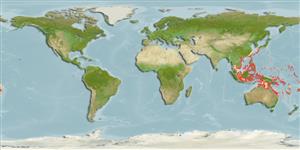Common names from other countries
Classification / Names / Names
आम नाम | उपशब्द | Catalog of Fishes (gen., sp.) | ITIS | CoL | WoRMS
Environment: milieu / climate zone / depth range / distribution range
पारिस्थितिकी
प्रवाल-भित्ति संयुक्त; गहराई सीमा 0 - 40 m (Ref. 848). Tropical; 36°N - 34°S, 80°E - 137°W (Ref. 848)
Indo-Pacific.
Length at first maturity / आकार / वज़न / Age
Maturity: Lm ? range ? - ? cm
Colony: massive, often small. Plocoid to tubular corallites. Primarily extratentacular budding. Equal and well developed costae. Often poorly developed paliform lobes. Small and compact columellae. Tentacles extend only at night. Color often brown, cream, or green with pale oral discs (Ref. 848).
Known from shallow reef environments, especially reef backs away from strong wave action (Ref. 848). Has low to moderate bleaching level in Palau (Ref. 66144).
Life cycle and mating behavior
परिपक्व अवधि | पुनरुत्पत्ति | मछलीऔ का अंडे देना | अंडे | Fecundity | लार्वा
Hermaphroditic (Ref. 113712). Mature gametes are shed into the coelenteron and spawned through the mouth. Life cycle: The zygote develops into a planktonic planula larva. Metamorphosis begins with early morphogenesis of tentacles, septa and pharynx before larval settlement on the aboral end (Ref. 833).
Veron, J.E.N. 2000. (Ref. 848)
IUCN Red List Status (Ref. 130435)
CITES status (Ref. 108899)
Not Evaluated
Human uses
| FishSource |
साधन
इंटरनेट स्रोत
Estimates based on models
Preferred temperature
(Ref.
115969): 25 - 28.9, mean 27.6 (based on 300 cells).
Price category
Unknown.
